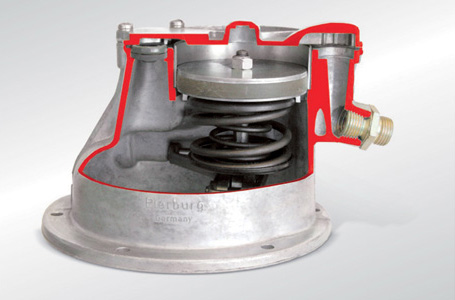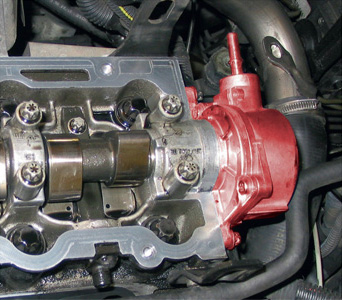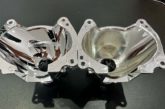
In many cases, vacuum pumps (highlighted in red, image below) are located directly on the cylinder head, and are driven by the camshaft.

Due to these ‘interfaces’, the engine repairer should have an elementary knowledge of vacuum pumps. Vacuum pumps are used in those motor vehicles for which the necessary vacuum cannot be generated in the intake manifold. These are direct injection engines, turbo engines and engines with variable valve timing, for example. The increasing number of pneumatic actuators can also render the use of a vacuum pump necessary. With pneumatic devices, high actuating forces can be achieved in a small installation space.
Brake boosters, secondary air valves, EGR valves, switched intake manifolds, turbocharger control and comfort devices are just some examples. Since failure of the brake boosters can lead to dangerous situations, the vacuum pump is considered to be a safety component.
Method of operation/types
The vacuum pumps used in motor vehicles generate a vacuum of approx. 0.7 – 0.9 bar. They suck the air out of the vacuum system and generally convey this to the cylinder head or the crankcase. In many cases, vacuum pumps are located directly on the cylinder head, are supplied with lubricating oil and driven by the camshaft. A vacuum pump’s method of operation depends on its design and is not visible from the outside. Formerly, piston (pictured below) or diaphragm vacuum pumps were predominantly used, which were driven by the cam, tappet, chain, belt or cam disc.

These days, vane pumps are used, which are mostly fitted to the end of the camshaft. New developments tend to combine pumps supplying different media (tandem pumps) – combined fuel/vacuum pumps are situated on an axle shared with the camshaft (see picture below) while combined vacuum/oil pumps are installed in the oil pan.

Continued use of a used vacuum pump in a reconditioned engine
Vacuum pumps are connected to the engine and, depending on their design, are incorporated in the engine oil circuit.
Following engine damage:
■ Chips may get into the vacuum pump along with the engine oil
■ The vacuum pump may have been damaged by overheating or another means
For this reason, to prevent consequential damage following engine repair, we recommend also replacing the vacuum pump when engine damage has occurred.









